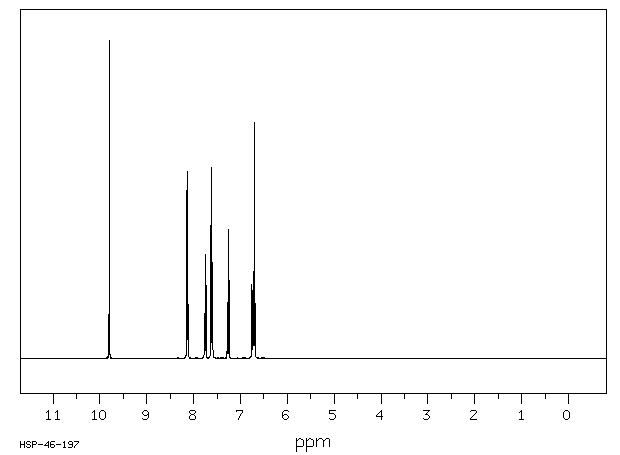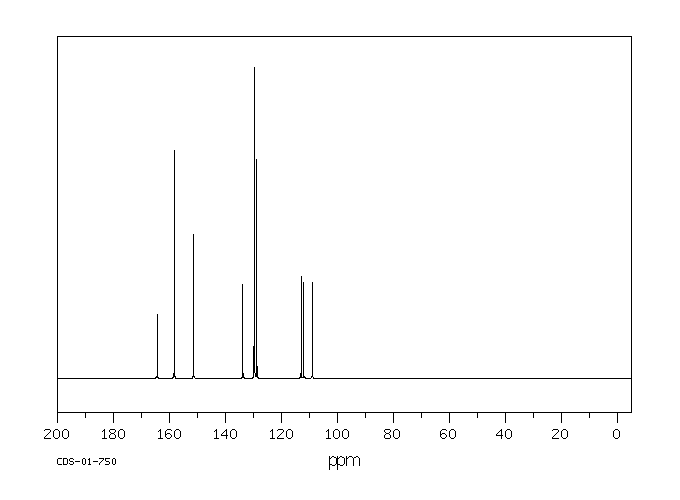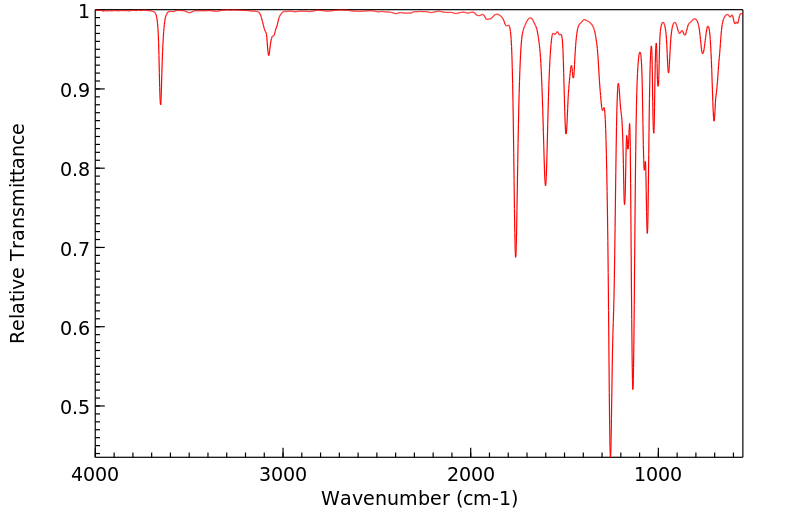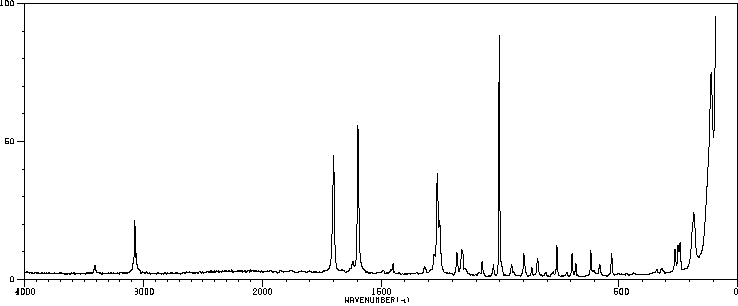1,3-苯二酚单苯甲酸酯 | 136-36-7
中文名称
1,3-苯二酚单苯甲酸酯
中文别名
苯甲酸3-羟基苯酯;间苯二酚单苯甲酸酯;3-羟苯基苯甲酸酯
英文名称
benzoate d'hydroxy-3 phenyle
英文别名
resorcinol monobenzoate;3-hydroxyphenyl benzoate;(3-hydroxyphenyl) benzoate
CAS
136-36-7
化学式
C13H10O3
mdl
MFCD00020118
分子量
214.221
InChiKey
GDESWOTWNNGOMW-UHFFFAOYSA-N
BEILSTEIN
——
EINECS
——
-
物化性质
-
计算性质
-
ADMET
-
安全信息
-
SDS
-
制备方法与用途
-
上下游信息
-
文献信息
-
表征谱图
-
同类化合物
-
相关功能分类
-
相关结构分类
物化性质
-
熔点:133-135 °C(lit.)
-
沸点:314.35°C (rough estimate)
-
密度:1.1956 (rough estimate)
-
溶解度:溶于甲醇
-
稳定性/保质期:
计算性质
-
辛醇/水分配系数(LogP):3.2
-
重原子数:16
-
可旋转键数:3
-
环数:2.0
-
sp3杂化的碳原子比例:0.0
-
拓扑面积:46.5
-
氢给体数:1
-
氢受体数:3
安全信息
-
TSCA:Yes
-
危险品标志:Xn
-
安全说明:S26,S36
-
危险类别码:R22,R36/37/38
-
WGK Germany:3
-
海关编码:29182900
-
RTECS号:VH2800000
-
储存条件:采用纸桶内衬塑料袋包装,并按照一般化学品的规定进行储存和运输。
SDS
Section 1. IDENTIFICATION OF THE SUBSTANCE/MIXTURE
Product identifiers
Product name : Resorcinol monobenzoate
CAS-No. : 136-36-7
Relevant identified uses of the substance or mixture and uses advised against
Identified uses : Laboratory chemicals, Manufacture of substances
Section 2. HAZARDS IDENTIFICATION
Classification of the substance or mixture
Classification according to Regulation (EC) No 1272/2008 [EU-GHS/CLP]
Acute toxicity, Oral (Category 4)
Skin irritation (Category 2)
Eye irritation (Category 2)
Specific target organ toxicity - single exposure (Category 3)
Classification according to EU Directives 67/548/EEC or 1999/45/EC
Harmful if swallowed. Irritating to eyes, respiratory system and skin.
Label elements
Labelling according Regulation (EC) No 1272/2008 [CLP]
Pictogram
Signal word Warning
Hazard statement(s)
H302 Harmful if swallowed.
H315 Causes skin irritation.
H319 Causes serious eye irritation.
H335 May cause respiratory irritation.
Precautionary statement(s)
P261 Avoid breathing dust/ fume/ gas/ mist/ vapours/ spray.
P305 + P351 + P338 IF IN EYES: Rinse cautiously with water for several minutes. Remove
contact lenses, if present and easy to do. Continue rinsing.
Supplemental Hazard none
Statements
According to European Directive 67/548/EEC as amended.
Hazard symbol(s)
R-phrase(s)
R22 Harmful if swallowed.
R36/37/38 Irritating to eyes, respiratory system and skin.
S-phrase(s)
S26 In case of contact with eyes, rinse immediately with plenty of water and
seek medical advice.
S36 Wear suitable protective clothing.
Other hazards - none
Section 3. COMPOSITION/INFORMATION ON INGREDIENTS
Substances
Formula : C13H10O3
Molecular Weight : 214,22 g/mol
Component Concentration
3-Dydroxyphenyl benzoate
CAS-No. 136-36-7 -
EC-No. 205-241-7
Section 4. FIRST AID MEASURES
Description of first aid measures
General advice
Consult a physician. Show this safety data sheet to the doctor in attendance.
If inhaled
If breathed in, move person into fresh air. If not breathing, give artificial respiration. Consult a physician.
In case of skin contact
Wash off with soap and plenty of water. Consult a physician.
In case of eye contact
Rinse thoroughly with plenty of water for at least 15 minutes and consult a physician.
If swallowed
Never give anything by mouth to an unconscious person. Rinse mouth with water. Consult a physician.
Most important symptoms and effects, both acute and delayed
To the best of our knowledge, the chemical, physical, and toxicological properties have not been
thoroughly investigated.
Indication of any immediate medical attention and special treatment needed
no data available
Section 5. FIREFIGHTING MEASURES
Extinguishing media
Suitable extinguishing media
Use water spray, alcohol-resistant foam, dry chemical or carbon dioxide.
Special hazards arising from the substance or mixture
Carbon oxides
Advice for firefighters
Wear self contained breathing apparatus for fire fighting if necessary.
Further information
no data available
Section 6. ACCIDENTAL RELEASE MEASURES
Personal precautions, protective equipment and emergency procedures
Use personal protective equipment. Avoid dust formation. Avoid breathing vapors, mist or gas. Ensure
adequate ventilation. Evacuate personnel to safe areas. Avoid breathing dust.
Environmental precautions
Do not let product enter drains.
Methods and materials for containment and cleaning up
Pick up and arrange disposal without creating dust. Sweep up and shovel. Keep in suitable, closed
containers for disposal.
Reference to other sections
For disposal see section 13.
Section 7. HANDLING AND STORAGE
Precautions for safe handling
Avoid contact with skin and eyes. Avoid formation of dust and aerosols.
Provide appropriate exhaust ventilation at places where dust is formed.Normal measures for preventive fire
protection.
Conditions for safe storage, including any incompatibilities
Store in cool place. Keep container tightly closed in a dry and well-ventilated place.
Specific end use(s)
no data available
Section 8. EXPOSURE CONTROLS/PERSONAL PROTECTION
Control parameters
Components with workplace control parameters
Exposure controls
Appropriate engineering controls
Handle in accordance with good industrial hygiene and safety practice. Wash hands before breaks and
at the end of workday.
Personal protective equipment
Eye/face protection
Safety glasses with side-shields conforming to EN166 Use equipment for eye protection tested
and approved under appropriate government standards such as NIOSH (US) or EN 166(EU).
Skin protection
Handle with gloves. Gloves must be inspected prior to use. Use proper glove removal technique
(without touching glove's outer surface) to avoid skin contact with this product. Dispose of
contaminated gloves after use in accordance with applicable laws and good laboratory practices.
Wash and dry hands.
The selected protective gloves have to satisfy the specifications of EU Directive 89/686/EEC and
the standard EN 374 derived from it.
Body Protection
Complete suit protecting against chemicals, The type of protective equipment must be selected
according to the concentration and amount of the dangerous substance at the specific workplace.
Respiratory protection
For nuisance exposures use type P95 (US) or type P1 (EU EN 143) particle respirator.For higher
level protection use type OV/AG/P99 (US) or type ABEK-P2 (EU EN 143) respirator cartridges.
Use respirators and components tested and approved under appropriate government standards
such as NIOSH (US) or CEN (EU).
Section 9. PHYSICAL AND CHEMICAL PROPERTIES
Information on basic physical and chemical properties
a) Appearance Form: powder
Colour: tan
b) Odour no data available
c) Odour Threshold no data available
d) pH no data available
e) Melting point/freezing Melting point/range: 133 - 135 °C - lit.
point
f) Initial boiling point and no data available
boiling range
g) Flash point no data available
h) Evaporation rate no data available
i) Flammability (solid, gas) no data available
j) Upper/lower no data available
flammability or
explosive limits
k) Vapour pressure no data available
l) Vapour density no data available
m) Relative density no data available
n) Water solubility no data available
o) Partition coefficient: n- no data available
octanol/water
p) Auto-ignition no data available
temperature
q) Decomposition no data available
temperature
r) Viscosity no data available
s) Explosive properties no data available
t) Oxidizing properties no data available
Other safety information
no data available
Section 10. STABILITY AND REACTIVITY
Reactivity
no data available
Chemical stability
no data available
Possibility of hazardous reactions
no data available
Conditions to avoid
no data available
Incompatible materials
Strong oxidizing agents
Hazardous decomposition products
Other decomposition products - no data available
Section 11. TOXICOLOGICAL INFORMATION
Information on toxicological effects
Acute toxicity
LD50 Oral - rat - 800 mg/kg
Inhalation: no data available
Skin corrosion/irritation
Serious eye damage/eye irritation
Eyes - rabbit -
Respiratory or skin sensitization
no data available
Germ cell mutagenicity
no data available
Carcinogenicity
IARC: No component of this product present at levels greater than or equal to 0.1% is identified as
probable, possible or confirmed human carcinogen by IARC.
Reproductive toxicity
no data available
Specific target organ toxicity - single exposure
Inhalation - May cause respiratory irritation.
Specific target organ toxicity - repeated exposure
no data available
Aspiration hazard
no data available
Potential health effects
Inhalation May be harmful if inhaled. Causes respiratory tract irritation.
Ingestion Harmful if swallowed.
Skin May be harmful if absorbed through skin. Causes skin irritation.
Eyes Causes serious eye irritation.
Signs and Symptoms of Exposure
To the best of our knowledge, the chemical, physical, and toxicological properties have not been
thoroughly investigated.
Additional Information
RTECS: VH2800000
Section 12. ECOLOGICAL INFORMATION
Toxicity
no data available
Persistence and degradability
no data available
Bioaccumulative potential
no data available
Mobility in soil
no data available
Results of PBT and vPvB assessment
no data available
Other adverse effects
no data available
Section 13. DISPOSAL CONSIDERATIONS
Waste treatment methods
Product
Offer surplus and non-recyclable solutions to a licensed disposal company. Contact a licensed
professional waste disposal service to dispose of this material. Dissolve or mix the material with a
combustible solvent and burn in a chemical incinerator equipped with an afterburner and scrubber.
Contaminated packaging
Dispose of as unused product.
Section 14. TRANSPORT INFORMATION
UN number
ADR/RID: - IMDG: - IATA: -
UN proper shipping name
ADR/RID: Not dangerous goods
IMDG: Not dangerous goods
IATA: Not dangerous goods
Transport hazard class(es)
ADR/RID: - IMDG: - IATA: -
Packaging group
ADR/RID: - IMDG: - IATA: -
Environmental hazards
ADR/RID: no IMDG Marine Pollutant: no IATA: no
Special precautions for user
no data available
Section 15. REGULATORY INFORMATION
This safety datasheet complies with the requirements of Regulation (EC) No. 1907/2006.
Safety, health and environmental regulations/legislation specific for the substance or mixture
no data available
Chemical Safety Assessment
no data available
Section 16. OTHER INFORMATION
Further information
Copyright 2012 Co. LLC. License granted to make unlimited paper copies for internal use
only.
The above information is believed to be correct but does not purport to be all inclusive and shall be
used only as a guide. The information in this document is based on the present state of our knowledge
and is applicable to the product with regard to appropriate safety precautions. It does not represent any
guarantee of the properties of the product. Corporation and its Affiliates shall not be held
liable for any damage resulting from handling or from contact with the above product. See
and/or the reverse side of invoice or packing slip for additional terms and conditions of sale.
制备方法与用途
上下游信息
-
上游原料
中文名称 英文名称 CAS号 化学式 分子量 1,3-二苯甲酰氧基苯 resorcinol dibenzoate 94-01-9 C20H14O4 318.329 苯甲酸苯酯 benzoic acid phenyl ester 93-99-2 C13H10O2 198.221 -
下游产品
中文名称 英文名称 CAS号 化学式 分子量 —— 3-Benzyloxy-1-benzoyloxy-benzol 96057-78-2 C20H16O3 304.345 1,3-二苯甲酰氧基苯 resorcinol dibenzoate 94-01-9 C20H14O4 318.329 —— 3-(vinyloxy)phenyl benzoate 1352571-18-6 C15H12O3 240.258 —— 3-allyloxyphenyl benzoate 80683-85-8 C16H14O3 254.285 —— benzoic acid 3-(2-amino-ethoxy)-phenyl ester 847413-20-1 C15H15NO3 257.289 —— 5-benzoyloxy-2-bromo-phenol 856079-41-9 C13H9BrO3 293.117 —— 3-(3-pyridylmethoxy)phenyl benzoate —— C19H15NO3 305.333 —— 3-(oxiran-2-ylmethoxy)phenyl benzoate 1042162-95-7 C16H14O4 270.285 —— 3-(cyclopentyloxy)phenyl benzoate —— C18H18O3 282.339 —— [3-[(2E)-3,7-dimethylocta-2,6-dienoxy]phenyl] benzoate 905552-90-1 C23H26O3 350.458 3-苄氧基苯酚 3-Benzyloxyphenol 3769-41-3 C13H12O2 200.237 1-(苄氧基)-3-甲氧基苯 3-benzyloxyanisole 21144-16-1 C14H14O2 214.264 5-苯甲酰氧基-2,4-二溴-苯酚 5-benzoyloxy-2,4-dibromo-phenol 856079-32-8 C13H8Br2O3 372.013 —— 3-benzoyl-6-nitroresorcinol 7539-24-4 C13H9NO5 259.218 —— Benzoic acid 3-(10-acetoxymethyl-anthracen-9-ylmethoxy)-phenyl ester 885481-28-7 C31H24O5 476.529 —— 3-(3-(triethoxysilyl)propylcarbamoyloxy)phenyl benzoate 1287767-60-5 C23H31NO7Si 461.587 2-碘-3-苯基甲氧基苯酚 3-(benzyloxy)-2-iodophenol 140201-75-8 C13H11IO2 326.134 —— 3-(pyridin-4-ylmethoxy)phenol —— C12H11NO2 201.225 —— 3-benzoyl-2-nitroresorcinol 108305-64-2 C13H9NO5 259.218 5-羟基-2-硝基苯基苯甲酸酯 3-benzoyl-4-nitroresorcinol 7539-18-6 C13H9NO5 259.218 - 1
- 2
反应信息
-
作为反应物:描述:参考文献:名称:214.间苯二酚单苯甲酸酯的溴化和4:6-二溴间苯三酚3-苯甲酸酯的硝化。组迁移的示例摘要:DOI:10.1039/jr9350000946
-
作为产物:描述:3-((1-tosyl-1H-1,2,3-triazol-4-yl)methoxy)phenyl benzoate 以 甲苯 为溶剂, 反应 24.0h, 以24%的产率得到1,3-苯二酚单苯甲酸酯参考文献:名称:热诱导脱氮环化法合成二氢喹啉亚胺和四色亚胺摘要:使用N-磺酰基-1,2,3-三唑类化合物制备各种有机分子的合成方法的快速发展引起了有机合成的极大兴趣。过渡金属通常用于活化α-亚氨基重氮中间体。尚未对无金属方法进行详细研究,但可以在温和的反应条件下很好地补充过渡金属催化作用。我们在此报告了一种在没有金属催化剂的情况下,由其相应的N-磺酰基-1,2,3-三唑类化合物制备2,3-二氢喹啉-4-亚胺和苯并吡喃-4-亚胺类似物的新方法。为了实现分子内环化,需要在N的间位引入一个给电子基团磺酰基1,2,3-三唑甲基苯胺 在苯胺部分和氮原子上包含特制的取代基可增强苯基π电子的亲核性,从而使它们能够与高度亲电的酮亚胺类进行Friedel-Crafts型反应。精心优化了这种无金属方法,以产生中等至良好产率的各种二氢喹啉-4-亚胺和苯并吡喃-4-亚胺。DOI:10.1002/asia.201501239
文献信息
-
HF–Pyridine: A Versatile Promoter for Monoacylation/Sulfonylation of Phenolic Diols and for Direct Conversion of <i>t</i>-Butyldimethylsilyl Ethers to the Corresponding Acetates作者:Kyosuke Michigami、Kazuya Yoshimoto、Masahiko HayashiDOI:10.1246/cl.2012.138日期:2012.2.5Monoacylation and trifluoromethanesulfonylation of phenolic diols were achieved by the aid of HF–pyridine, whereas diacylation occurred with pyridine alone. Furthermore, HF–pyridine was found to promote the direct conversion of t-butyldimethylsilyl ethers to the corresponding acetates.
-
OXIME ESTER PHOTOINITIATORS申请人:BASF SE公开号:US20180208583A1公开(公告)日:2018-07-26Compounds of the formulae (I) or (II) wherein X is A is O, S, NR 5 or CR 16 R 17 ; R 1 is for example hydrogen or C 1 -C 20 alkyl R 2 is for example hydrogen, C 1 -C 20 alkyl or C 6 -C 20 aryl R 5 for example is C 1 -C 20 alkyl; R 7 , R 8 , R 9 , R 10 and R 11 for example independently of each other are hydrogen. C 1 -C 20 alkyl, halogen, CN or NO 2 ; Ar 1 is for example unsubstituted or substituted C 6 -C 20 aryl, C 3 -C 20 heteroaryl, C 6 -C 20 aroyl, C 3 -C 20 heteroarylcarbonyl or or Ar 1 is Ar 2 is for example phenylene, all of which are unsubstituted or substituted M is for example unsubstituted or substituted C 1 -C 20 alkylene Y is a direct bond, O, S, NR 5 or CO; Z 1 is for example O or S; Z 2 is a direct bond, O, S or NR 5 ; and Q is CO or a direct bond.公式(I)或(II)的化合物 其中 X是 A是O, S, NR 5 或CR 16 R 17 ; R 1 例如是氢或C 1 -C 20 烷基 R 2 例如是氢, C 1 -C 20 烷基或C 6 -C 20 芳基 R 5 例如是C 1 -C 20 烷基; R 7 , R 8 , R 9 , R 10 和R 11 例如彼此独立是氢. C 1 -C 20 烷基, 卤素, CN或NO 2 ; Ar 1 例如是不取代或取代的C 6 -C 20 芳基, C 3 -C 20 杂芳基, C 6 -C 20 芳酰基, C 3 -C 20 杂芳基甲酰基或 或Ar 1 是 Ar 2 例如是苯基, 所有这些都不取代或取代 M例如是不取代或取代的C 1 -C 20 亚烷基 Y是直接键, O, S, NR 5 或CO; Z 1 例如是O或S; Z 2 是直接键, O, S或NR 5 ; 和 Q是CO或直接键。
-
Method for the preparation of aromatic chloroformates申请人:Davis Charles Gary公开号:US20060293535A1公开(公告)日:2006-12-28A method for preparing an aromatic chloroformate comprising, introducing a mixture of at least one aromatic hydroxyl compound, phosgene, at least one solvent, and at least one organic base into a flow reactor to obtain a unidirectionally flowing reaction mixture. The unidirectionally flowing reaction mixture is maintained at a temperature between about 0° C. and about 60° C. to produce a single product stream comprising an aromatic chloroformate.
-
A molecular gate based on a porphyrin and a silver lock作者:Aur?lie Guenet、Ernest Graf、Nathalie Kyritsakas、Lionel Allouche、Mir Wais HosseiniDOI:10.1039/b706527b日期:——A Sn(IV) metallaporphyrin bearing a 4-pyridyl group on one meso position and a handle equipped also with a pyridyl unit functions in solution as a molecular gate in the presence of silver cation: the complexation–decomplexation of Ag(I) corresponds to the opening and closing motions of the gate.
-
[EN] 2-(3,5-DISUBSTITUTEDPHENYL)PYRIMIDIN-4(3H)-ONE DERIVATIVES<br/>[FR] DÉRIVÉS DE 2-(3,5-DISUBSTITUTEDPHENYL)PYRIMIDIN-4(3H)-ONE申请人:PFIZER公开号:WO2011158149A1公开(公告)日:2011-12-22O N NH R3 R2 O R1 168 ABSTRACT The present invention provides a 2-(3,5-disubstitutedphenyl)pyrimidin- 4(3H)-one compound of Formula (I) 5 (I) or a pharmaceutically acceptable salt thereof wherein R 1, R2 and R3 are as defined herein. The compounds of Formula (I) have been found to act as glucokinase activators. Consequently, the compounds of Formula (I) and 10 the pharmaceutical compositions thereof are useful for the treatment of diseases, disorders, or conditions mediated by glucokinase.
表征谱图
-
氢谱1HNMR
-
质谱MS
-
碳谱13CNMR
-
红外IR
-
拉曼Raman
-
峰位数据
-
峰位匹配
-
表征信息
同类化合物
非那米柳
雷尼替丁
降钙素(humanreduced),8-L-缬氨酸-(9CI)
间苯甲酰氧基苯乙酮
间苯二甲酸二苯酯
间甲苯基苯甲酸酯
间双没食子酸
醋氨沙洛
邻苯二甲酸苄酯2-乙己基酯
邻苯二甲酸二苯酯-D4
邻苯二甲酸二苯酯
邻甲苯基苯甲酸酯
邻氨基苯甲酸(4-硝基苯基)酯
邻亚苯基二苯甲酸酯
贝诺酯
袋衣酸
血竭黄烷A
萘-1,5-二磺酸-4-[2-(二甲氨基)乙氧基]-2-甲基-5-(丙烷-2-基)苯基2-氨基苯酸酯(1:1)
茶痂衣酸
苯酚,2-[2-[(4-氯苯基)氨基]-4-噻唑基]-,苯酸酯(ester)
苯甲醯柳酸甲酯
苯甲酸苯酯
苯甲酸五氟苯酯
苯甲酸丁香酚酯
苯甲酸4-[[(4-甲氧基苯基)亚甲基]氨基]苯基酯
苯甲酸4-(乙酰氨基)-2-[[2-[4-(乙酰氨基)苯甲酰基]亚肼基]甲基]苯基酯
苯甲酸2-(2-苯并恶唑基)苯酯
苯甲酸-4-甲基苯酯
苯甲酸-(4-环戊基-苯基酯)
苯甲酸-(2-烯丙基-4-溴-苯基酯)
苯甲酸-(2-溴-4,6-二硝基-苯基酯)
苯甲酸-(2,4-二溴-3-甲基-苯基酯)
苯甲酸-(2,4-二氯-5-甲基-苯基酯)
苯甲酸-(2,4-二叔丁基苯基酯)
苯甲酸,4-羟基-,4-[(4-羟基苯氧基)羰基]苯基酯
苯甲酸,4-羟基-,4-(己氧基)苯基酯
苯甲酸,4-羟基-,4-(十四烷氧基)苯基酯
苯甲酸,4-羟基-,4-(十二烷氧基)苯基酯
苯甲酸,4-甲酰基-,4-(辛氧基)苯基酯
苯甲酸,4-甲氧基-,2-甲酰基苯基酯
苯甲酸,4-甲基-,4-甲基苯基酯
苯甲酸,4-戊基-,4-(壬氧基)苯基酯
苯甲酸,4-丁氧基-,1,4-亚苯基酯
苯甲酸,4-[[[3-[(2,2-二甲基-1-羰基丙氧基)甲基]-3,4-二氢-2-甲基-4-羰基-6-喹唑啉基]甲基]-2-炔丙基氨基]-,五氟苯基酯
苯甲酸,4-[1-(己氧基)乙基]-,4-(辛氧基)苯基酯
苯甲酸,4-(辛氧基)-,4-[[4-[[(1-甲基庚基)氧代]羰基]苯基]乙炔基]苯基酯
苯甲酸,4-(苯基甲氧基)-,4-(癸氧基)苯基酯
苯甲酸,4-(苯基甲氧基)-,4-(壬氧基)苯基酯
苯甲酸,4-(苯基甲氧基)-,4-(十二烷氧基)苯基酯
苯甲酸,4-(癸氧基)-,4-[氰基[(1-羰基戊基)氧代]甲基]苯基酯,(R)-











